What is the difference between volatile and synchronize?
Difference: 1. Volatile will not cause thread blocking; synchronized may cause thread blocking. 2. Volatile guarantees the visibility of data, but cannot guarantee atomicity; while synchronized can guarantee atomicity and indirectly guarantee visibility.

Visibility
Visibility: A thread pair After a shared variable is modified, other threads can immediately see (perceive) the modification (change) of the variable.
The Java memory model synchronizes the modified values of variables in the working memory to the main memory, and refreshes the latest values from the main memory to the working memory before reading the variables. This method relies on main memory. to achieve visibility.
Atomicity (atomicity)
Atomicity: An operation cannot be interrupted, either all executions are completed or not executed .
What the Java memory model guarantees is that all operations within the same thread are from top to bottom. However, when multiple threads are running in parallel, the orderliness of their operations cannot be guaranteed.
Orderliness
Orderliness: Observed in this thread, the operations are all in order; if in a When observing another thread in a thread, all operations are out of order.
What the Java memory model guarantees is that all operations within the same thread are from top to bottom. However, when multiple threads are running in parallel, the orderliness of their operations cannot be guaranteed. .
When the computer executes a program, in order to improve performance, the compiler and processor often rearrange the instructions, which are generally divided into the following three types
Single-threaded environment It ensures that the final execution result of the program is consistent with the result of the code execution
The processor must consider the data dependency between instructions when reordering In a multi-threaded environment, threads execute alternately. Due to the existence of compiler optimization rearrangement, it is uncertain whether the variables used in the two threads can ensure the consistency of the variables used, and the results are unpredictable.
Do what you know how to do in the exam first, and do what you can't do later.
public void mySort(){
int x = 11; //1
int y = 12; //2
x= x+5; // 3
y = x*x;//4because of data dependency.
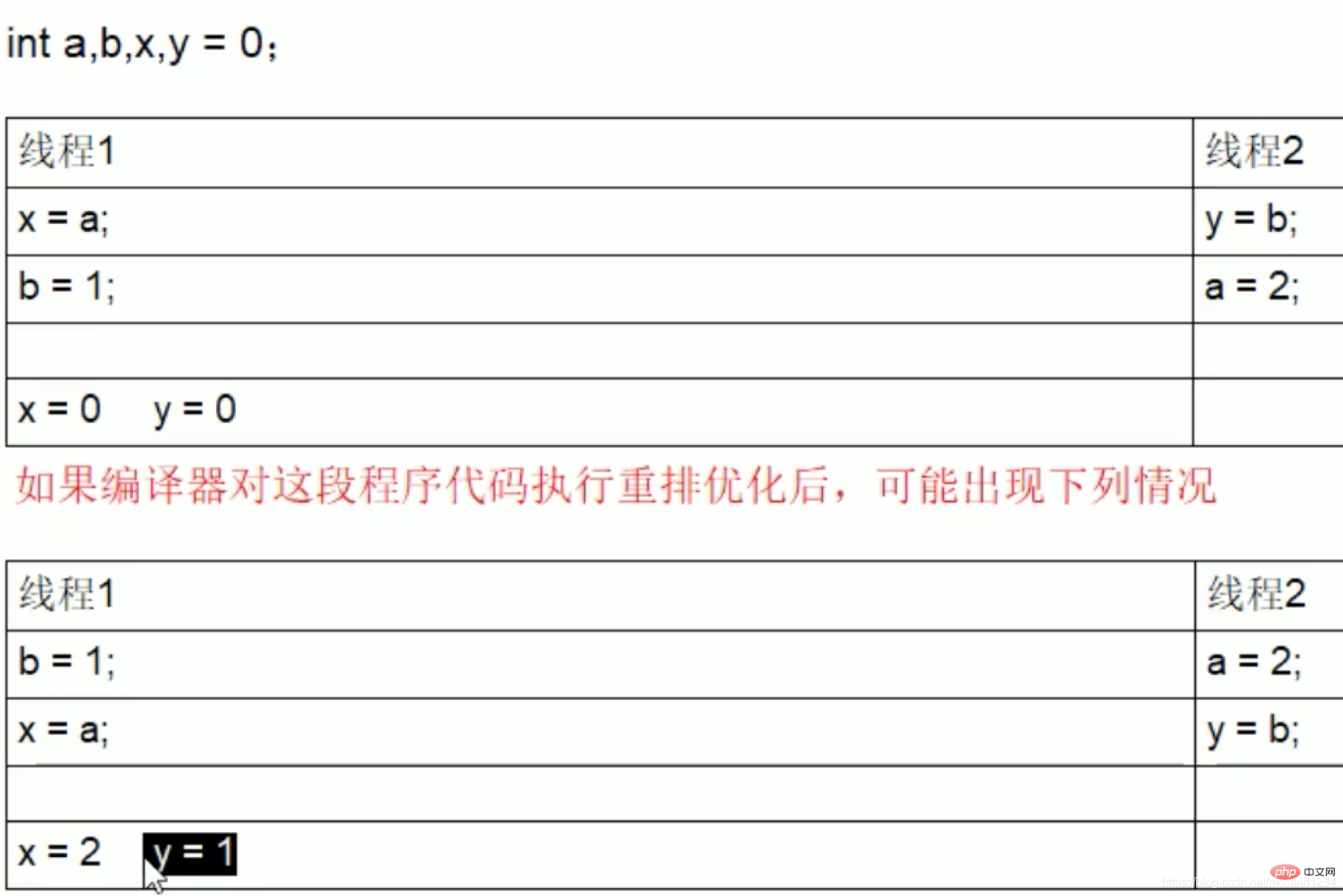 # volatile prohibits instruction reordering.
# volatile prohibits instruction reordering.
public class ReSortSeqDemo {
int a = 0;
boolean flag = false;
public void method01() {
a = 1; // flag = true;
// ----线程切换----
flag = true; // a = 1;
}
public void method02() {
if (flag) {
a = a + 3;
System.out.println("a = " + a);
}
}
}Disable instruction sorting
volatile realizes the optimization of disabling instruction reordering, thus avoiding the phenomenon of program disorder in multi-threaded environmentFirst understand a concept. Memory Barrier, also known as memory barrier, is a CPU instruction. It has two functions: Guarantee the execution order of specific operations Ensure a certain The memory visibility of some variables (use this feature to achieve volatile memory visibility)
Since the compiler and every processor can perform instruction reordering optimization, if a Memory Barrier is inserted between instructions, it will tell the compiler and CPU, No instruction can reorder this Memory Barrier instruction, which means that reordering optimization before and after the memory barrier is prohibited by inserting a memory barrier. Another function of the memory barrier is to force the flushing of various CPU cache data, so that any thread on the CPU can read the latest version of these data.
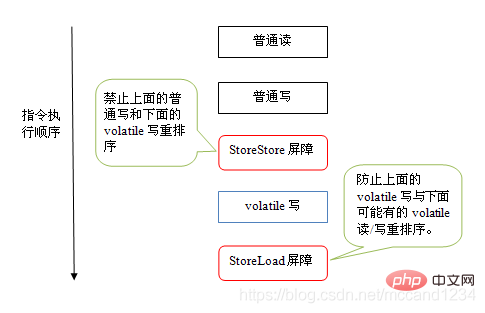 The following is the instruction sequence generated after volatile reading inserts the memory barrier under the conservative strategy Schematic diagram:
The following is the instruction sequence generated after volatile reading inserts the memory barrier under the conservative strategy Schematic diagram: 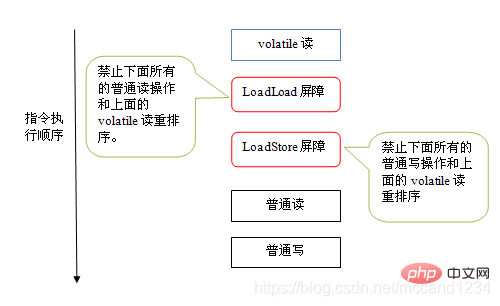
Thread safety guarantee
The synchronization delay between working memory and main memory causes visibility problems Can be solved using the synchronzied or volatile keywords, which can use variables modified by one thread to be immediately visible to other threads
For visibility problems and ordering problems caused by instruction rearrangement
can be solved using the volatile keyword, Because another function of volatile is to prohibit instruction reordering optimization
volatile
thevariable## it modifies #Do not retain the copy, directly access the main memory . In the Java memory model, there is main memory, and each thread also has its own memory (such as registers). For performance, a thread keeps a copy of the variables it accesses in its own memory. In this way, there will be situations where the value of the same variable in the memory of one thread may be inconsistent with the value in the memory of another thread or the value in main memory at a certain moment. Declaring a variable as volatile means that the variable can be modified by other threads at any time, so it cannot be cached in thread memory. Usage scenarios You can only use volatile variables to replace locks in limited situations. For volatile variables to provide ideal thread safety, the following two conditions must be met at the same time: volatile is most suitable for situations where one thread writes and multiple threads read. synchronized When it is used to modify a method or a code block , it can ensure At most one thread can execute this code at the same time. Lock Starting from jdk 5.0, java provides a more powerful thread synchronization mechanism - synchronization is achieved by explicitly defining synchronization lock objects, and synchronization locks are used Lock object acts as. The java.util.concurrent.Locks.Lock interface is a tool for controlling multiple threads' access to shared resources. Locks provide exclusive access to shared resources. Only one thread can lock the Lock object at a time. The thread should obtain the Lock object before starting to access the shared resources. The ReentrantLock class implements Lock, which has the same concurrency and memory semantics as synchronized. In achieving thread-safety control, ReentrantLock is more commonly used, and can display locks and release locks. The difference volatile and synchronized volatile is a variable modifier, while synchronized acts on a piece of code or method . volatile just synchronizes the value of a variable between thread memory and "main" memory; while synchronized synchronizes the value of all variables by locking and unlocking a monitor, obviously synchronized is better than volatile consumes more resources. volatile will not cause thread blocking; synchronized may cause thread blocking. volatile guarantees the visibility of data, but cannot guarantee atomicity; while synchronized can guarantee atomicity and indirectly guarantee visibility. , because it will synchronize the data in private memory and public memory. Variables marked volatile will not be optimized by the compiler; variables marked synchronized can be optimized by the compiler. Thread safety includes two aspects: atomicity and visibility. Java's synchronization mechanism focuses on these two aspects to ensure thread safety. The keyword volatile prompts the thread to read variables from shared memory each time instead of reading from private memory, thus ensuring the visibility of synchronized data. But please note: if you modify the data in the instance variable For example: i, that is, i=i 1, then such an operation is not actually an atomic operation, that is, it is not thread-safe. The operation steps of expression i are broken down as follows: synchronized and Lock Lock is an explicit lock (manually open and close, don’t forget to turn off the lock), synchronized is an implicit lock, out of scope Automatically release the lock. For more programming-related knowledge, please visit: Programming Learning Course! !
1)The write operation to the variable does not depend on the current value.
2) The variable is not included in an invariant with other variables.
If there are multiple threads writing concurrently, you still need to use locks or thread-safe containers or atomic variables instead.
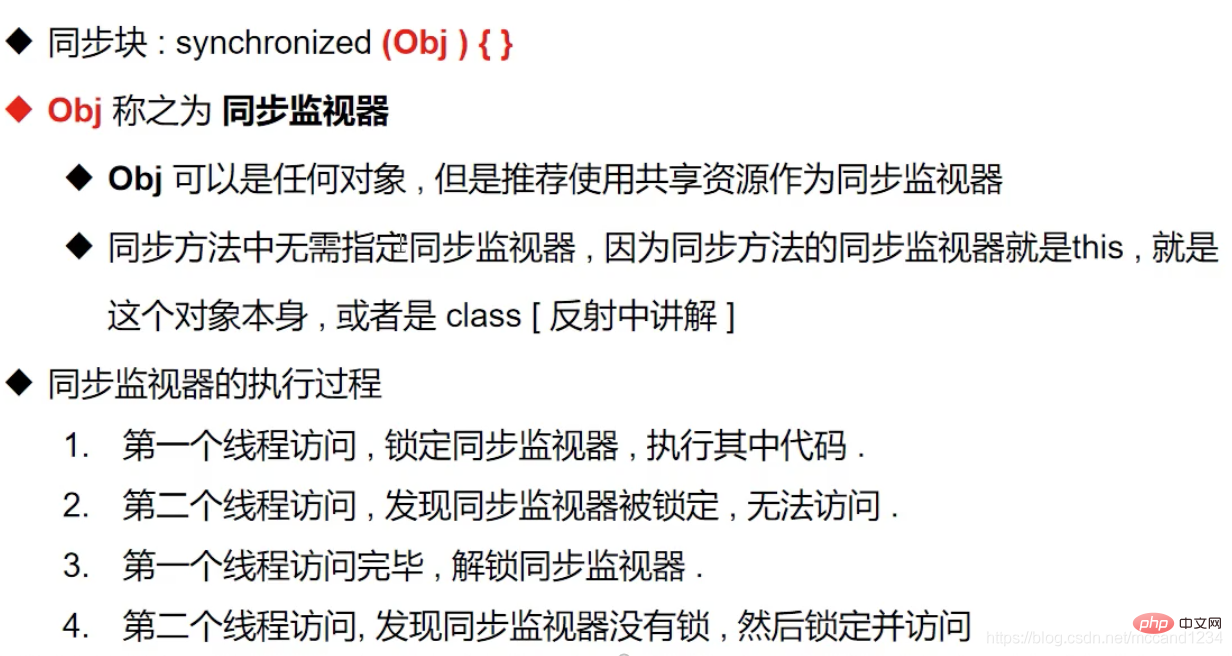
Shared resources and objects added, deleted, and modified. 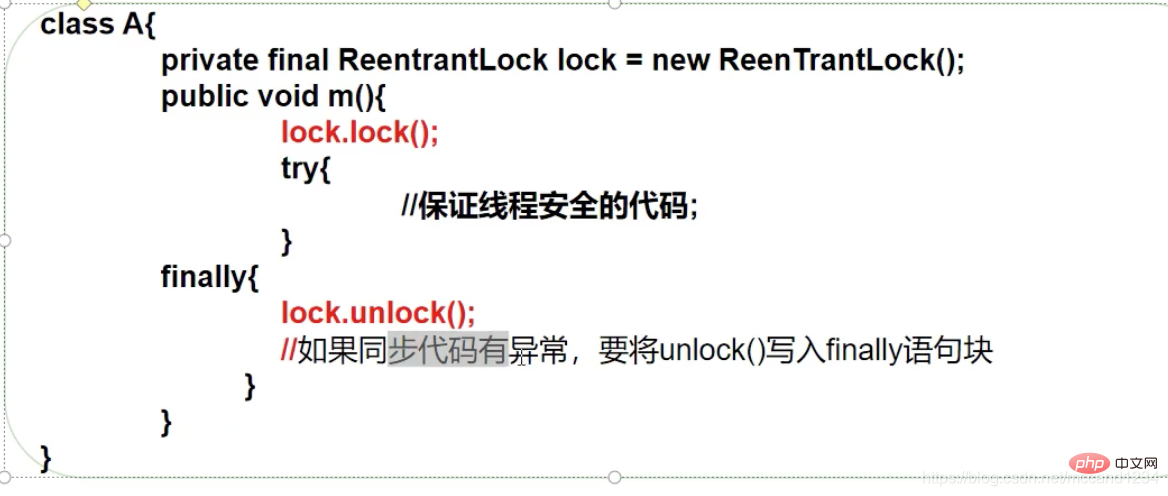
The keyword volatile is mainly used when multiple threads can detect that instance variables have been modified and can obtain the latest value. That is, when multiple threads read shared variables, they can obtain the latest value.
1) Get the value of i from memory.
2) Calculate the value of i;
3) Write the value of i to memory.
If another thread also modifies the value of i when calculating the value in step 2, dirty read data will appear in name at this time. The solution is to use the synchronized keyword. So volatile itself does not deal with the atomicity of data, but forces the reading and writing of data to affect the main memory in a timely manner.
Lock only locks code blocks, synchronized can act on code blocks and methods.
Using Lock lock, jvm spends less time scheduling threads and has better performance. And has better scalability (providing more subclasses).
Sequence of use: Lock-> synchronized code block (has entered the method body and allocated corresponding resources) -> synchronized method (outside the method body).
The above is the detailed content of What is the difference between volatile and synchronize?. For more information, please follow other related articles on the PHP Chinese website!

Hot AI Tools

Undresser.AI Undress
AI-powered app for creating realistic nude photos

AI Clothes Remover
Online AI tool for removing clothes from photos.

Undress AI Tool
Undress images for free

Clothoff.io
AI clothes remover

AI Hentai Generator
Generate AI Hentai for free.

Hot Article

Hot Tools

Notepad++7.3.1
Easy-to-use and free code editor

SublimeText3 Chinese version
Chinese version, very easy to use

Zend Studio 13.0.1
Powerful PHP integrated development environment

Dreamweaver CS6
Visual web development tools

SublimeText3 Mac version
God-level code editing software (SublimeText3)

Hot Topics
 Square Root in Java
Aug 30, 2024 pm 04:26 PM
Square Root in Java
Aug 30, 2024 pm 04:26 PM
Guide to Square Root in Java. Here we discuss how Square Root works in Java with example and its code implementation respectively.
 Perfect Number in Java
Aug 30, 2024 pm 04:28 PM
Perfect Number in Java
Aug 30, 2024 pm 04:28 PM
Guide to Perfect Number in Java. Here we discuss the Definition, How to check Perfect number in Java?, examples with code implementation.
 Random Number Generator in Java
Aug 30, 2024 pm 04:27 PM
Random Number Generator in Java
Aug 30, 2024 pm 04:27 PM
Guide to Random Number Generator in Java. Here we discuss Functions in Java with examples and two different Generators with ther examples.
 Armstrong Number in Java
Aug 30, 2024 pm 04:26 PM
Armstrong Number in Java
Aug 30, 2024 pm 04:26 PM
Guide to the Armstrong Number in Java. Here we discuss an introduction to Armstrong's number in java along with some of the code.
 Weka in Java
Aug 30, 2024 pm 04:28 PM
Weka in Java
Aug 30, 2024 pm 04:28 PM
Guide to Weka in Java. Here we discuss the Introduction, how to use weka java, the type of platform, and advantages with examples.
 Smith Number in Java
Aug 30, 2024 pm 04:28 PM
Smith Number in Java
Aug 30, 2024 pm 04:28 PM
Guide to Smith Number in Java. Here we discuss the Definition, How to check smith number in Java? example with code implementation.
 Java Spring Interview Questions
Aug 30, 2024 pm 04:29 PM
Java Spring Interview Questions
Aug 30, 2024 pm 04:29 PM
In this article, we have kept the most asked Java Spring Interview Questions with their detailed answers. So that you can crack the interview.
 Break or return from Java 8 stream forEach?
Feb 07, 2025 pm 12:09 PM
Break or return from Java 8 stream forEach?
Feb 07, 2025 pm 12:09 PM
Java 8 introduces the Stream API, providing a powerful and expressive way to process data collections. However, a common question when using Stream is: How to break or return from a forEach operation? Traditional loops allow for early interruption or return, but Stream's forEach method does not directly support this method. This article will explain the reasons and explore alternative methods for implementing premature termination in Stream processing systems. Further reading: Java Stream API improvements Understand Stream forEach The forEach method is a terminal operation that performs one operation on each element in the Stream. Its design intention is






